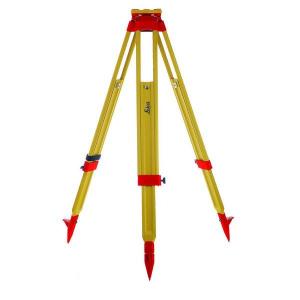
Add to Cart
Leica GST103 Aluminum Telescopic Tripods for Dump Levels and Rotating Laser Levels Instruments
Model: GST20-9
Specifications:
| Model | GST20-9 |
| Color | Yellow |
| Material | Wooden |
| Type | Flat Head Tripods |
| Closed Height | 1100mm |
| Extension Height | 1800mm |
| Head Diameter | 160mm |
| Locking Type | Screw |
| Net Weight | 6.4Kg |
| Package | 1pc/Carton |
GST20-9 Instroduction:
Overview:
1. Heavy Duty tripod with carrying strap and side clamp screws.
2. Proven long-life, twist-proof and excellent vibration characteristics.
3. Packaged lenght 110cm, extendible to 180cm, weight 6.4Kg
What makes a twist lock tripod so unique?
One possibly unique feature is that the leg locks have a secondary locking system that prevents you from loosening the locks and completely removing a leg section. Many photographers new to twist-locks often have anxiety filled moments when they accidently disassemble the tripod while trying to extend it!
The Tripod Feet
The feet probably suffer the most wear and tear of all the tripod components. Some tripods offer replaceable feet. This way if anything does happen to the feet you can just replace them with out having to replace the whole tripod. There are also optional feet covers available for indoor use. When steel tips become more of a hazard than a help. The covers provide a good slip resistant base for the tripod. And, as most land surveyors know, the feet need to be strong for pushing into the ground to get a stable set-up.
The Clamps
On a surveying tripod, the clamps hold the legs in place when they are extended.
Quick Clamp Tripods - can be set quickly. Simply extend the legs to the desired height and flip the lever. This will lock the legs in place. Some surveyors prefer not to use the quick clamps because if something accidentally catches the lever it could unintentionally unlock the clamp. Quick clamps do feature a bolt to adjust how tight the clamp will lock. Quick clamp tripods are great if your work requires frequent and multiple set ups.
Screw Clamp Tripods - To use a screw clamp set the tripod to the desired height and hand-tighten the screws to the desired tension. The screw can be located on the center or on the side of the clamp. Screw clamps take a little longer to set up but cannot be accidentally unlocked easily, which helps protect heavier surveying instruments from a collapsing tripod. We also recommend screw clamp tripods when the user plans to use heavier instruments like robotics, total stations, or GPS equipment since the screw clamps get tighter and theres less chance of a clamp slipping loose and causing a tripod to fall over damaging the instrument.


